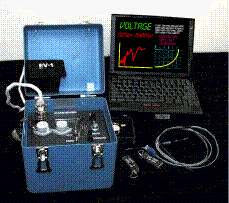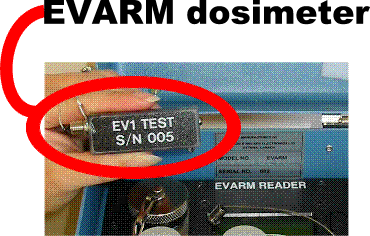|
For astronauts working is space it is important to monitor their total absorbed dose of cosmic radiation.
The actual measurement and comparison of absorbed radiation is a complex problem because each type of incident radiation interacts differently with the atoms and molecules it encounters. Bone, for example, absorbs protons more efficiently than muscle; and 3MeV protons are less biologically hazardous than 3MeV alpha particles. |
In order to make meaningful measurements of an absorbed dose, the following conditions must be satisfied.
|
 The complete EVARM system. The large box contains the electronics for calibrating and reading the dosimeter. The dosimeter data can be uploaded to a laptop computer for further analysis and data transfer. The dosimeters are the small, self-contained units in the foreground. |
| In the past century of medical physics scientists have acquired a wealth of data about the radiological sensitivity of human tissues and organs to radiation of various types, including both high energy photons and high energy particles. For astronauts working in space the radiation is almost entirely protons. Condition 1 is therefore easily satisfied.
The problem then is to determine how much energy is absorbed from incident cosmic radiation (which arises almost entirely from solar and galactic protons). To solve this problem Canadian scientists have developed a very small and accurate dosimeter that can be easily worn by astronauts to measure their absorbed dose. Called the EVARM (ExtraVehicular Activity Radiation Monitor) dosimeter, its small size allows astronauts to wear the dosimeter during their EVA time. The heart of the EVARM is a small solid state crystal that undergoes a slight, but measurable change in response to the impact of a high energy particle such as a proton. The change in the crystal is irreversible and therefore contains a permanent record of all proton impacts. The crystal produces a small voltage when a current is applied to it. The output voltage depends upon the particle impact history of the crystal. To measure an absorbed dose the output voltage of the crystal is read before and after exposure. The change between the initial and final output voltage of the crystal has been calibrated so that the output voltage-change difference can be converted into millisieverts of absorbed dose. The EVARM can measure absorbed doses from about 0.5mSv to 10Sv. The photo below shows a close-up of one of the three EVA suit dosimeters and a diagram of their body placement locations for an astronaut during an EVA schedule.
When in use the dosimeters require no external attachments. They are only connected to |

